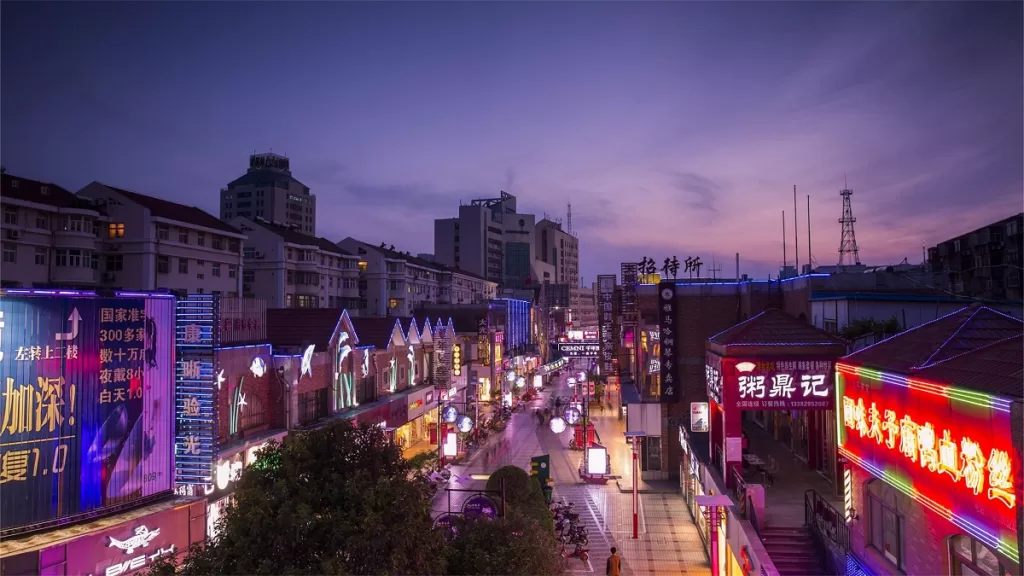Haizhou Ancient City (海州古城) is the origin and starting point of Lianyungang, with a history spanning over 2000 years. Since the Qin and Han dynasties, it has been the political, economic, and cultural center of the Hai, Gan, Shu, and Guan regions, earning prestigious titles like “Huai Kou Grand Town,” “Donghai Famous County,” and the “First City from Huaihai to Donghai.”
Founded during the Qin Dynasty, Emperor Qin Shi Huang established the Quxian County in Haizhou in 212 BC, erecting a stone stele marking it as the “Eastern Gate of Qin.” During the Qin and Han periods, Haizhou emerged as a flourishing open port capable of hosting dozens of merchant ships. Emperor Qin Shi Huang’s three visits during his five Eastern expeditions further solidified Haizhou as the sole gateway open to the sea at the time.
However, in modern times, the ancient city faced challenges, including the 1668 Tancheng earthquake and the 1939 Japanese bombings, ultimately leading to its near disappearance during the Great Leap Forward and the Cultural Revolution’s “Breaking the Four Olds” campaign. The current architectural landscape mostly stems from the 1991 restoration and reconstruction efforts.
Table of Contents
- Basic Information
- Location and Transportation
- Highlights of Haizhou Ancient City
- Vlog about Haizhou Ancient City
- Attractions near Haizhou Ancient City
Basic Information
| Estimated Length of Tour | 1 – 2 hours |
| Ticket Price | 15 RMB |
| Opening Hours | 24 hours a day throughout the year |
Location and Transportation
Haizhou Ancient City is situated in the southwestern part of Haizhou District, Lianyungang City, Jiangsu Province, China. Its precise address is 61 Zhongdajie (Middle Street). To get there, tourists can take bus 24, 27, 202, or Tourist Line 1 and get off at Drum Tower Stop (鼓楼站).
Highlights of Haizhou Ancient City
Zhengyuan Tower

Zhengyuan Tower, the city gate, stands approximately 4 meters high, with an inner diameter of 3.15 meters and a length of 10.38 meters. Originally featuring a bell and drum tower, now only the inscription stone of the Ming Dynasty, erected by the Ming Governor of Haizhou, Wang Tong, remains intact. This historical stone, measuring 2.5 meters in height, 1.03 meters in width, and 0.28 meters in thickness, provides valuable insights into the construction and restoration of the city gate. It bears witness to the city’s significance since the early Ming period. The city gate, constructed with bricks measuring 33x13x8 centimeters, underwent restoration in 1991, and in 2014, replicas of the octagonal wind chimes from the original bell and drum tower destroyed by Japanese bombings in the 1930s were installed.
Qushan Academy

Established in 1759 during the Qing Dynasty, Qushan Academy was founded by Governor Li Yongshu, who used personal funds to purchase land and construct the academy buildings. Serving as a hub for learning and education, it invited Li Ying from Yixing to be the dean. Renowned for its serene environment, the academy became a significant place for study and academic pursuits. Over time, it evolved into a “small school” during the Jiaqing period.
Shuanglong Well

Located outside the old southern gate of Haizhou, Shuanglong Well, originally named Shajing or Dajing, is unique with three wells forming the shape of the Chinese character “品” (pin), hence also known as “Pinquan.” While most wells south of the gate have salty water, Shuanglong Well offers sweet and pleasant water year-round. The well features two stone-carved dragon heads, continuously spouting water, creating a picturesque scene. In the Ming Dynasty, a “Pinquan Pavilion” was constructed here, providing visitors with a charming spot to explore and enjoy refreshing moments.
Bixia Temple

Situated at the eastern foot of Baihushan, Bixia Temple, initially known as Bixia Palace, is also referred to as Nainai Temple. Founded in 1324 during the Yuan Dynasty, it was reconstructed during the Qing Shunzhi period as a place of worship for Bixia Niangniang (Goddess of the Blue Dawn). The architectural style follows patterns from the late Ming to early Qing eras, featuring a well-preserved main hall with three sections and a rear hall with five sections. A stone stele, inscribed with the “Record of Oil Fields” in the tenth year of the Shunzhi period (1653), serves as a historical testament to the restoration after the earthquake of Kangxi 7 (1668). In 1997, during the construction of the Daxiong Baodian, the main hall was shifted 30 meters south while preserving its original layout. Both structures are now recognized as municipal-level cultural heritage units.
Xie Xiyu Mansion

Located on Zhongdajie (Middle Street) in Haizhou, the Xie Xiyu Mansion was constructed in 1934 in the architectural style of Northern European residences. Built by local scholar Xie Xiyu, the mansion now serves as an office building for the Haizhou Public Security Sub-Bureau. Designed by a Dutch architect and constructed by workers from Qingdao, it shares the same historical period with other Haizhou landmarks like the Lianyungang Railway Station office building and the Clock Tower. The building, measuring 7.5 meters in height and comprising 14 rooms with a total area of 256 square meters, features a central fireplace and a chimney connecting the upper and lower levels. With a unique asymmetrical layout, large inclined roofs covered with large tiles, and Dutch-style skylights, it stands as the first modern European-style architecture in the Haizhou region.





In the morning before leaving, I asked the driver to take me on a tour, but it turned out to be a bit of a scam. They said it was an ancient city, but it seems like it has been reconstructed at the original site, everything looks very new. There are two archways, with a bell and drum tower in the middle as a city gate, facing a commercial street that feels very lively. This is the so-called Haizhou Ancient… Read more »